ONE OF THE MOST Hopi VINTAGE NAVAJO TURQUOISE STERLING SILVER NECKLACE
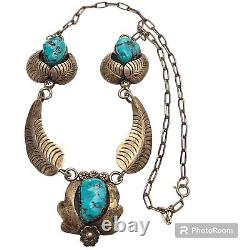
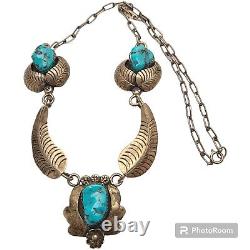
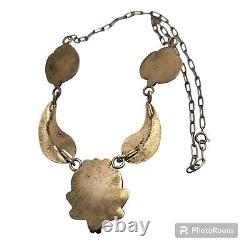
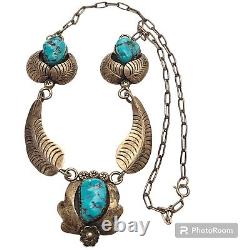
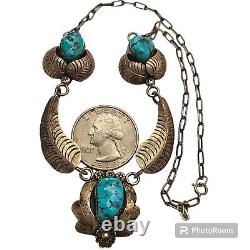
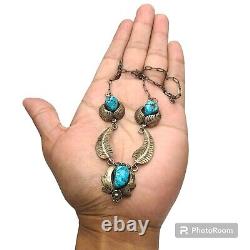

We are proud to offer this museum worthy vintage Hopi necklace featuring 3 silver pendants with Morenci turquoise stones, handcarved silver leaves, silver stems, and a silver flower, with a silver clasp! Sterling silver, by Hopi artist, The length of the necklace measures around 15¾ Sturdy 16.6 grams. No marks but tested as sterling silver great addition to your collection??
The Hopi are Arizona's oldest permanent residents; a peaceful tribe that settled on ancestral lands overlooking northern Arizona more than one thousand years ago. They reside on three scenic mesas that boast the nation's oldest continuously inhabited village. Like their Southwestern neighbors, the Zuni and Navajo, ornamentation has played an integral role in the Hopi's culture and history. The early Hopi produced carvings and beads crafted from stones, shell, bone and wood.
These items were not only beautiful, but often served a spiritual function. As we know it today came into existence much later, long after the tribe was first introduced to the art of silversmithing. According to author Lois Sherr Dubin, Sikyatala of Walpi was the first Hopi to be initiated into the craft. Despite his knowledge, few Hopi tradesmen incorporated silver into their lapidary work. The scarcity of mined silver likely contributed to the lack of new jewelry produced during this time period, as shell casings and household items were among the few sources of precious metals available.
Those who did follow in Sikyatala's footsteps crafted necklaces and bracelets that were virtually indistinguishable from the work of the Navajo and Zuni tribes. That changed in 1946, when Willard Beatty helped to implement a U. Government silversmithing program for indigenous veterans. Beatty's classes introduced a smithing technique called overlay, in which a design is punched out of one sheet of silver and the cut sheet soldered onto another plate of silver.
The visible areas of the lower sheet are then darkened using a patina agent such as liver of sulphur. This technique evolved post-WWII, when artists and cultural experts at the Museum of Northern Arizona assisted in giving tribe members a signature artistic style that would differentiate Hopi jewelry from the work of other tribes. The Hopi jewelry available today is a merging of modern technique and ancient cultural symbolism. Sun and water themes are commonly seen on overlay jewelry, along with kachina figures. The meaning of the kachina varies within Hopi culture: some believe it is a supernatural creature that provides rain, while others view the doll-like figure as a liaison between man and the gods. Tribe members dress as kachinas in some seasonal celebrations; this is thought to temporarily imbue the person with the kachina spirit. Whatever the meaning, it is clear that the Hopi are a creative, spiritual people.These qualities translate to their jewelry, which uses a modern method of working silver as a base to present mythology that has been central to the Hopi way of life for over a thousand years.

